Recent Articles
Popular Makes
Body Types
2017 GMC Acadia Road Test and Review
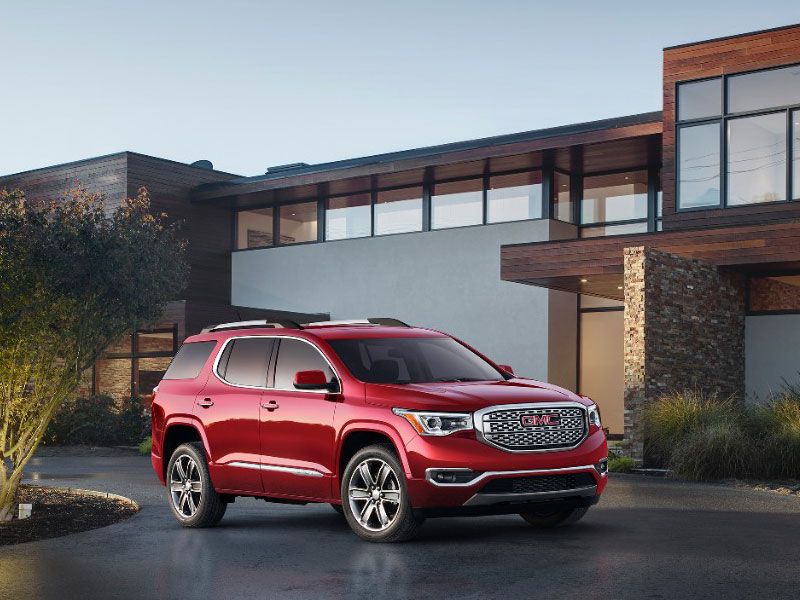
2017 GMC Acadia frontangle ・ Photo by General Motors
Reviewing a car is a lot like discussing the weather: The worse it is, the more there is to talk about. Ask people from Buffalo about meteorological matters, and they’ll go on for hours (if not days!) if you let them. Ask someone from San Diego, and they’ll say “It’s lovely,” and wait for you to change the subject. The conversation about the weather is effectively over.
It’s the same deal with car reviews. If the GMC Acadia was really terrible, we could go on for hours (if not days!) about all the things that are wrong with it. But the GMC Acadia is not Buffalo; it’s San Diego. Look at the photos, and if the Acadia appeals to you, go to the dealership and test-drive one. We’re pretty sure you’ll come to the same conclusion we did: Like the weather in San Diego, it’s lovely.
A New Mission for Acadia
A little background, if you please: GMC first launched the Acadia in 2007, and it was followed by three mechanical twins, the Buick Enclave, Chevrolet Traverse, and now-defunct Saturn OUTLOOK. The Acadia was intended to be a more sensible alternative to jumbo SUVs like the Chevrolet Suburban and Ford Excursion. It offered seating for up to eight passengers, just like the big guys, but it was really a crossover, or CUV, meaning it was built like a car (load-carrying body, front-wheel-drive layout) rather than a truck (load-carrying frame with a bolt-on body, rear-drive layout). It traded heavy-duty towing and serious off-road ability for better space efficiency and higher fuel economy, though it was still thirstier than smaller seven-seat crossovers.
If you’ve seen the old GMC Acadia, you’ll notice that the new 2017 version is a lot smaller. GMC has adopted an “If you can’t beat ‘em, join ‘em” mentality by downsizing the Acadia to compete with seven-seaters like the Toyota Highlander, Infiniti Q60, Honda Pilot, and Mazda’s new CX-9. The new Acadia is 7.2 inches shorter, 3.5 inches narrower, and a whopping seven hundred and fifty pounds lighter than the old version—though GMC attributes only 200 lbs. of weight loss to the Acadia’s smaller size, the rest coming from smart engineering and extensive use of high-strength steel.
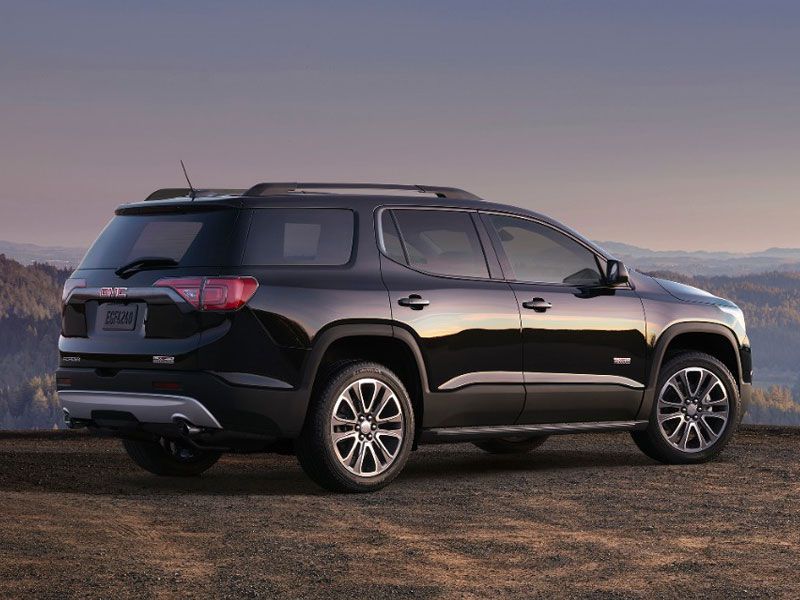
Photo by General Motors
Space: Not As Much, But Still Plenty
Though it may be smaller, the new Acadia doesn’t skimp on accommodations. We were impressed by the comfort of the second row, which features adjustable seats that slide fore and aft. And the third row? Well… that’s not so great. Unlike the old Acadia, the new Acadia’s third row is a temporary perch best suited for kids. It sits close to the floor, necessitating a knees-up seating position, and the second row seats must slide forward in order to provide a humane amount of legroom. GMC, like other brands, has found that while buyers want a third-row seat, they rarely use it—and the Acadia’s rear-most seat is sized accordingly.
That said, the Acadia does at least offer consolation prizes to those who must sit in the way-back: While they may not get much in the way of room or comfort, they do get their own air conditioning vents, a USB port, and reading lights, at least in top-end models. (At least they can suffer in comfort!)
With the third row seat in place, the Acadia offers a reasonable 12.8 cubic feet of cargo space. If you’re planning on a vacation or a Costco run, though, you’ll have to fold that seat down for 41.7 cubic feet of space. What? A sale on those delicious Kirkland Signature cheese and spinach ravioli, but you have to buy them by the case? No problem—drop down that second-row seat and your Acadia will accommodate 79 cubic feet of cheesy, spinachy goodness.
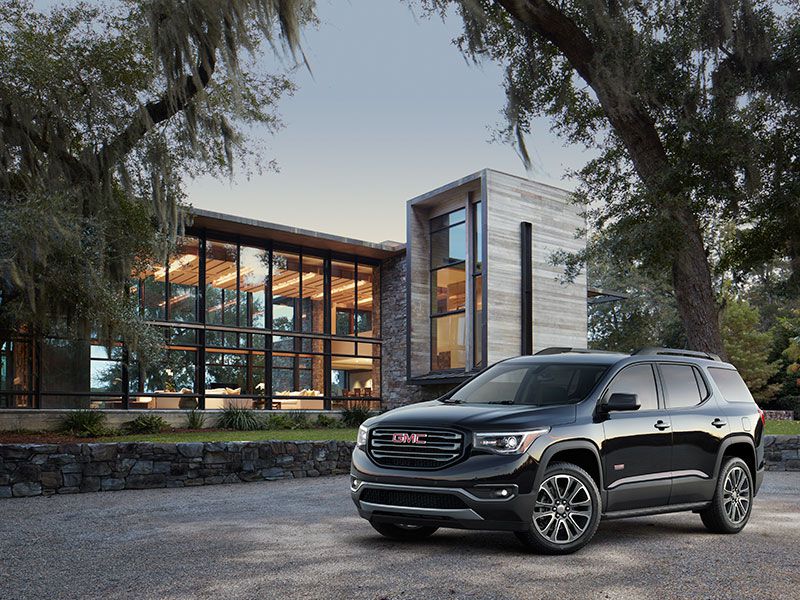
Photo by General Motors
High-Quality Cabin
Speaking of comfort, let’s have a closer look at the Acadia’s cabin, starting up front. We like what General Motors has done with the dashboard: The design is attractive and sensible, something we appreciate considering the lengths some luxury brands have gone to make their interiors look unique (instead winding up with a design that is just plain ugly). There’s an emphasis on genuine materials (wood, metal, and, of course, good ol’ genuine plastic), and trim has been applied with restraint.
More important is the layout: There’s lots of real estate on the Acadia’s dashboard, and GMC’s designers have put it to good use. Occupying center stage is a 7-inch touchscreen stereo with GM’s IntelliLink software (and a big, simple volume and power knob right beneath). Having used all sorts of touch-screen systems, we think GM’s is among the best, with colorful graphics and big, easy-to-see icons, including icons up top that make it easy to switch between stereo, phone, and (optional) navigation screens. Speaking of navigation, even if you don’t opt for the full-on built-in system, every Acadia comes with OnStar, a subscription-based system to which you can call in and get turn-by-turn directions. It’s not as flexible as a traditional nav system, but it works a treat and beats the daylights out of trying to use Google Maps on your smartphone while driving.

Photo by General Motors
Sometimes Simple Is Best
Below the screen you’ll find a simple set of controls for the Acadia’s dual-zone climate control system. It sits above a nice big center console storage bin, home to the Acadia’s USB and power ports. Just aft is the shifter (a good ol’ fashioned P-R-N-D-L lever; General Motors has mercifully not succumbed to the desire to overcomplicate this classic design) arranged side by side with a pair of big cupholders. Just behind that, a comfortable armrest covers a sizable storage cubby.
The fat, leather-wrapped steering wheel feels good in one’s hands, with steering wheel buttons that control stereo, cruise control, and trip computer functions. Opt for a lower-trim Acadia and you’ll be looking at easy-to-read analog gauges on the instrument panel; higher trims get a color screen in the center that provides stereo info and next-turn directions. On the top-of-the-line Acadia, the entire center section of the screen—including the speedometer—is a full-color video display. Cool!
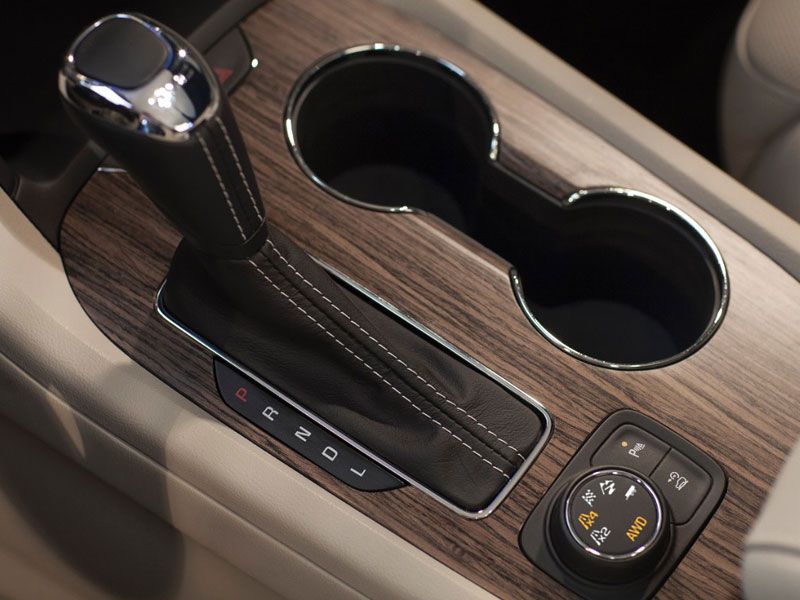
Photo by General Motors
An Electronic Guardian Angel
Safety is a buzzword for every family vehicle, and we want to talk about what we think is one of the Acadia’s best (and most underrated) safety features: OnStar. We mentioned this subscription-based system’s ability to provide turn-by-turn directions a moment ago, but one of its most important functions is crash notification. If the Acadia is in an accident—and if the electrical bits are all still working—OnStar automatically places a call to a human advisor, who will check to see if you need help. If you don’t answer—or if you can’t answer—the advisor can pinpoint the Acadia’s location using OnStar’s GPS sensor, and summon emergency services to the vehicle. OnStar is limited by cell coverage, but it uses a variety of carriers and may be able to connect when your cell phone can’t. (It also has an SOS button should you want to summon help on your own.)
We’ve seen the system in action when one of our testers had a minor altercation with a roadside barrier, a hit hard enough to bend the fenders but not hard enough to deploy the airbags. Within seconds, a representative had called our driver to make sure he was okay. OnStar is standard in the Acadia and all General Motors vehicles, and we think it’s one of the best safety features available; in a sense, it’s like a real-world guardian angel.

Photo by General Motors
Safety Features
Other standard safety features include a plethora of airbags, like side curtain protection for all three rows, a driver’s knee airbag, a center airbag mounted on the inboard side of the driver’s seat, and a rear-view camera. As you move up to higher trim levels and option packages, the Acadia adds automatic low-speed braking, collision warning and mitigation, lane departure warning and correction, blind-spot warning, and front and rear parking assistance. These latter systems use GM’s “Safety Alert” seat—instead of loud beepers and flashing lights, the Acadia’s seat vibrates at the front or sides, giving a noticeable but silent warning that won’t have your passengers questioning your driving abilities.
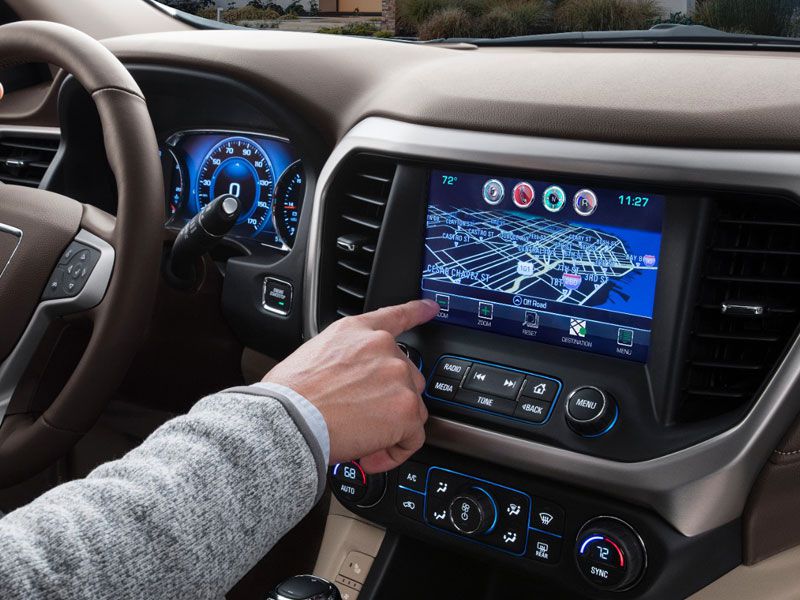
Photo by General Motors
Why Lighter Weight Matters
Let’s talk about that whole weight-reduction thing. General Motors, GMC’s parent company, has been on a tear when it comes to weight reduction. The benefits of shedding weight are manifold: Lighter vehicles need less engine to power them, which means they get better fuel economy. It also means there is less mass to change directions, so they handle better (and if you’re wondering why handling matters in a seven seat SUV, ask anyone who has had a child dart out from between two parked cars). Normally, better handling is a trade-off for ride comfort, but a lighter vehicle need not make such compromises.
While the old Acadia was powered by GM’s trusty 3.6-liter V6 engine, the new one gets a 2.5-liter four-cylinder engine—the same size engine you’ll find powering your typical mid-size sedan. The Acadia is closing in on two tons, but with 194 horsepower and 190 lb.-ft of torque from the four-cylinder engine—output similar to V6s from just a few years back—the 2.5 does a better job than you might think, and frankly the most disconcerting thing about it is the noise (it’s weird to hear a four-cylinder buzz from such a big SUV).
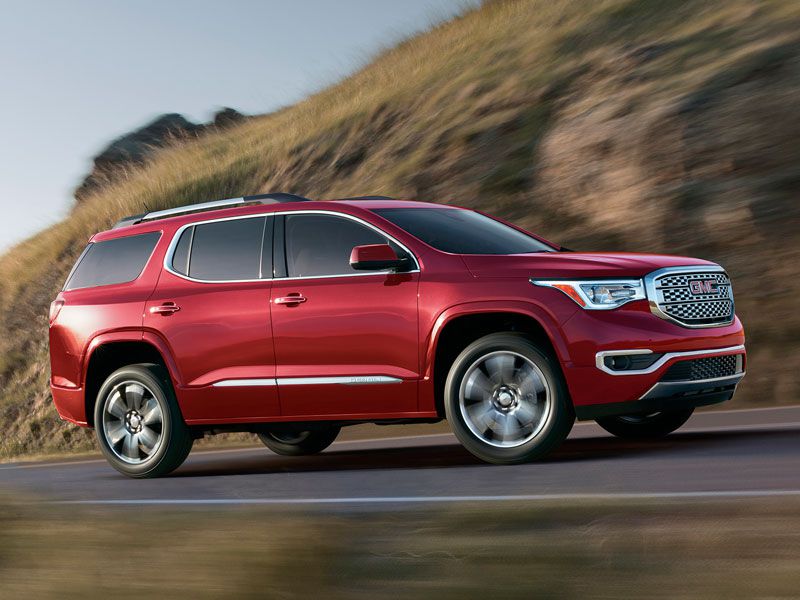
Photo by GMC
Four-Cylinder Power or Traditional V6
The four-cylinder engine features an auto-stop feature that shuts the engine off at stoplights, then restarts it when the driver releases the brake pedal. This may sound disconcerting to those who have not experienced it—or to those who have experienced it in a car made by BMW, whose system does not work all that well—but trust me when I tell you that GM does the best auto-stop in the business, and you’ll hardly notice the engine starting and stopping. Auto-stop reduces pollution and increases real-world fuel economy, though the benefits don’t really show in the EPA figures. Speaking of which, they are 21 MPG city / 26 MPG highway with front-wheel-drive and 21 / 25 with all-wheel-drive, good numbers for a seven-seater.
Higher trim levels get a new version of our old familiar friend, GM’s 3.6-liter V6. This is a freshly-updated version of the engine—so freshly updated that GM didn’t have certified power figures when we wrote this review, instead giving us estimates of 310 hp and 271 lb.-ft. This engine is smooth and very, very quick, and like the four-cylinder it employs a six-speed automatic transmission. EPA fuel economy estimates are 18 MPG city and 25 MPG highway for both front- and all-wheel-drive versions, so if you do most of your driving on the highway, there’s really not much fuel economy penalty, though stop-and-go driving will favor the four cylinder.
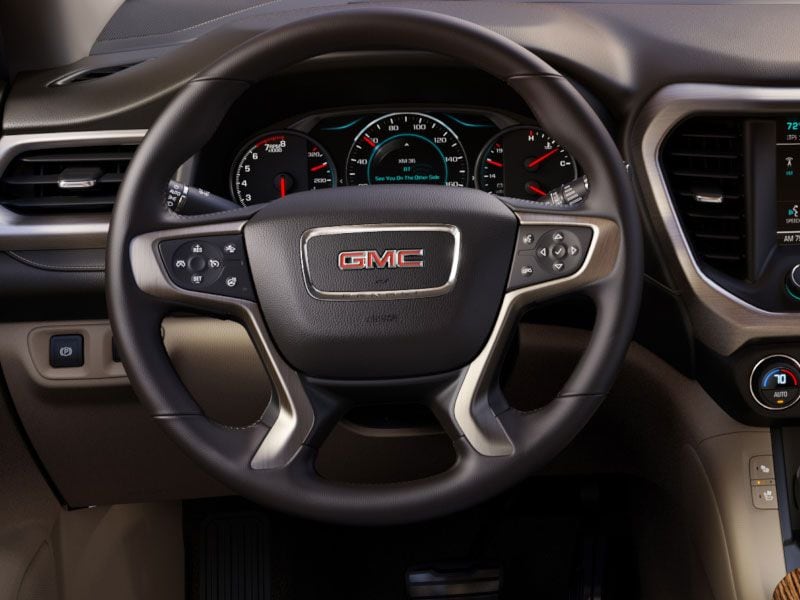
Photo by General Motors
Acadia vs. The Competiton
We think GMC has made a sensible move with the Acadia. It’s now sized to compete against some of the industry’s best sellers, and it’s a nicely-trimmed, well-built, comfortable vehicle to boot. With prices starting at $29,995 for a front-drive Acadia SL and a full-boat GMC Acadia Denali selling for $56,700, the Acadia can be had as inexpensively as non-premium seven-seaters like the Toyota Highlander, while top-end versions cost less than luxury-branded SUVs like the Land Rover LR4.
Our one caveat—common with other seven-seaters—is the lack of third-row space. If you regularly use that third row, you’ll be better served by a Ford Explorer or a Honda Pilot, which offer more room for seven. And if you need all those seats plus cargo space, open up that wallet and go check out the GMC Yukon XL or its fraternal twin, the Chevrolet Suburban.
But if five seats plus two “occaisionals” will do you, then we highly recommend you test drive the GMC Acadia. It’s handsome, functional, and easy to live with. Or as the San Diego weather report would say, it’s lovely.
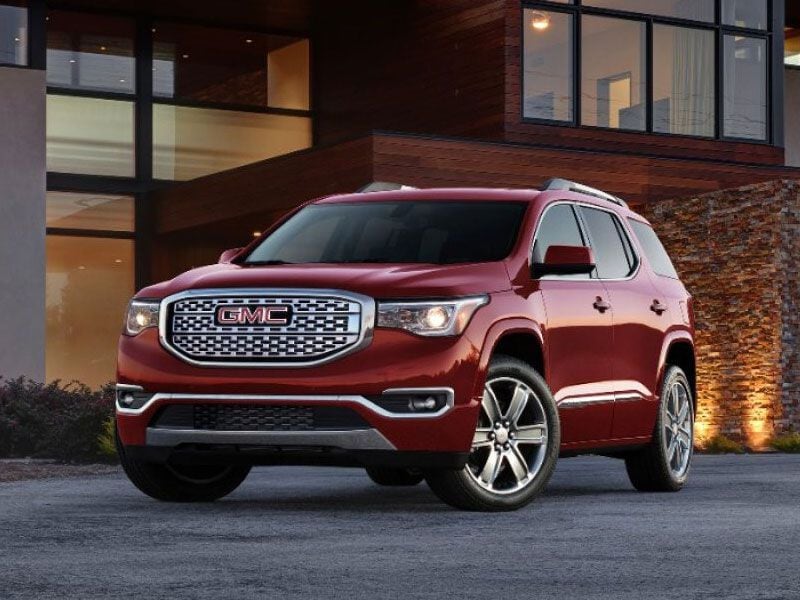
Photo by General Motors